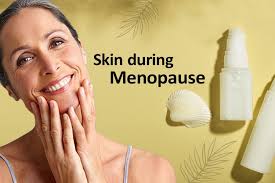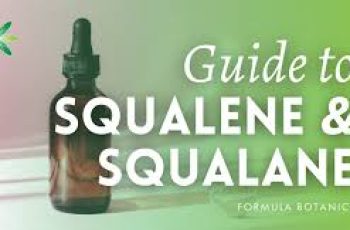Here’s how your skin changes during the three stages of menopause
Menopause will be different for everyone. But the three stages of this life-changing experience are pretty much set in stone and will trigger major changes to your skin.
Unfortunately, if you have a uterus, I can assure you that you’ll start experiencing dryness starting around age 50.
Here’s what happens before, during, and after menopause.
Perimenopause
This is the first stage, which usually starts in the mid-forties and lasts for three to four (long, exhausting, confusing) years. At this point, periods become very irregular as estrogen levels begin to drop. And trigger a systemic reaction.
You may get hot flashes – so your skin may get very red. Sometimes women also get rosacea at this time. Outbreaks are not uncommon. Skin that was previously stable and balanced may start to develop dry or oily patches.
Menopause
I lied to you a little about the whole “stage” info. Because technically, menopause is just one day. The day that marks a full year since your last menstrual cycle.
Skin-related changes aren’t as dramatic here. You may notice that your skin (body and face) looks thinner and less plump, and that’s because there’s a very close relationship between collagen production, skin thickness, and estrogen deficiency. Cell turnover slows down significantly, and fewer naturally occurring moisturizers in the skin can make dryness worse.
Postmenopause
Once you reach this stage, you’re there to stay. Estrogen levels will stabilize at a lower level at this point. The menopausal symptoms you’ve been enduring gracefully for nearly a decade should lessen (whoops) and eventually disappear altogether (it’s about time).
So! Grab a cup of tea and get comfortable. As you know, your skin type has changed, and your face at this point is a good indicator of what “issues” may still be present.
What are the best products for menopausal skin?
Retinoids.
Vitamin A in whatever form is best for you. This active ingredient helps repair skin, stimulate collagen production, fight fine lines and wrinkles, and even out skin tone. It’s fine for long-term use as long as the product/formula you choose doesn’t leave you feeling dry or cause irritation.
Peptides.
This skin savior packs some powerful anti-aging benefits. Peptides, the building blocks of protein and collagen, promote firmness and elasticity, giving your skin back its plumpness and tone. This is a must-have in your daily routine if you want to slow down the signs of aging.
Glycerin.
Perhaps the unsung hero of the skincare world? Glycerin is the master of hydration, and it’s totally non-irritating. A regenerative ingredient that works best to reduce moisture loss by holding moisture to the surface of the skin, preventing further dryness. Good.
Hyaluronic Acid.
A hydrating essential for all skin types. This moisture-trapper, hyaluronic acid, is a molecule that attracts, binds, and retains moisture in the skin. If your face is thirsty, tired, and generally sad, this ingredient will bring back the freshness and plumpness you’ve been craving.
On top of all that, sunscreen is a must. Every day. Even in the winter.
DQH Can I use salicylic acid first and then vitamin C?
It’s easy to create a skincare routine, but knowing how to use it is another thing entirely. In most cases, if you’re not getting the desired skin results, it could be due to the layering of conflicting ingredients. So, is it possible that salicylic acid and vitamin C are such ingredients? Or are these active ingredients the duo that’s been missing from your skincare routine? If you want answers, stick around because today we are going to explain the benefits of salicylic acid and vitamin C and how they can be used in your daily life.
What are the benefits of salicylic acid for skin?
Salicylic acid is one of the most commonly used beta hydroxy acids and is favored by many people with oily, acne-prone skin. This acid is derived from willow bark, and unlike its water-soluble relatives (called alpha-hydroxy acids), salicylic acid is oil-soluble, which means it can penetrate deeper into the lower layers of the skin. Once it reaches the lower layers, it can help unclog pores of excess sebum, dirt, bacteria, debris, and impurities. This results in clearer skin tones and greater definition.
Not only does salicylic acid benefit the underlying layers, but the outer surface of the skin benefits as well. When applied to the skin, salicylic acid removes the buildup of dead skin cells. This is accomplished by breaking the bonds that hold dead cells to the surface. Over time, this can cause the complexion to look dull and prone to acne, blackheads, and other blemishes.
If you’d like to learn more about salicylic acid and how it can improve your skin, check out this dedicated blog post from a beauty insider.
What are the benefits of vitamin C for skin?
Vitamin C is considered one of the most powerful antioxidants, which means it is very effective at fighting free radicals and preventing them from causing further skin damage. Examples of free radicals include pollution, central heating, UV rays and harsh climate. They attack proteins, fats and cell membranes as soon as they come into contact with the skin, causing signs of premature aging such as fine lines and wrinkles as well as hyperpigmentation, flaky patches of skin and loss of elasticity.
Many people usually prefer to use vitamin C in their morning routine as this ingredient gives the complexion a radiant glow. You’ll also find that vitamin C can target areas of hyperpigmentation, plumping the skin and reducing the appearance of fine lines and wrinkles.
The thing about vitamin C is that there are a lot of outdated studies going back to the 1950s that describe vitamin C as an unstable skin component. Thanks to improvements in modern technology, this is no longer the case as all products now contain a stable form of vitamin C.
Visit The Beauty Insider to learn more about vitamin C. So please check out our blog post.
Can I use salicylic acid first and then vitamin C?
Yes, you absolutely can. In fact, it’s thought that using salicylic acid before using vitamin C ensures it penetrates faster and works faster.
This is an efficient way to utilize two power sources, and the reason has to do with pH. For example, the skin’s natural pH is about 4.7, making it slightly acidic. Salicylic acid and vitamin C are also both acidic, and you’ll find that vitamin C is absorbed quickly into the skin. Therefore, using salicylic acid beforehand can increase the acidity of the skin and allow vitamin C to penetrate into the skin faster.
While this is considered an effective way to combine two powerful ingredients, you need to be aware of your skin type and how it reacts to certain active ingredients. Even people with perfect, normal skin can experience skin sensitivity and irritation. Therefore, always consult a doctor or dermatologist before using any new products on your skin.
It’s also important to follow skin application rules. In this case, you need to use the product correctly to ensure you get the best results for your skin. If you’re not sure what I mean, the basic rule for skin is to start with the thinnest consistency and work your way up to the thickest consistency. This prevents a barrier from forming on the surface, preventing other active ingredients from penetrating the skin.
Can I use salicylic acid at night and vitamin C in the morning?
Yes, absolutely, this is considered the most effective way to get returns without any adverse side effects. This is because there is enough time between applications to ensure that the skin’s pH levels return to balance.
You’ll also find that Vitamin C is rich in antioxidants and is perfect for use in the morning to ensure your skin is protected and looking its healthiest. Due to the small size of salicylic acid molecules, it is an acid that is able to reach the deepest parts of the skin. While this is effective at keeping skin clear, it also increases the risk of irritation and photosensitivity. Therefore, many people prefer to use powerful BHAs in their evening routine without exposure to UV rays, pollution, or harsh weather.
Warning: If you avoid using sunscreen every day, none of these ingredients will do what your skin needs. The combination of chemical peels and powerful ingredients increases the risk of further damage to the skin’s surface. Use SPF 50 every day to keep your skin protected and your lipid barrier healthy, even on cloudy days, keeping your skin in top condition.



